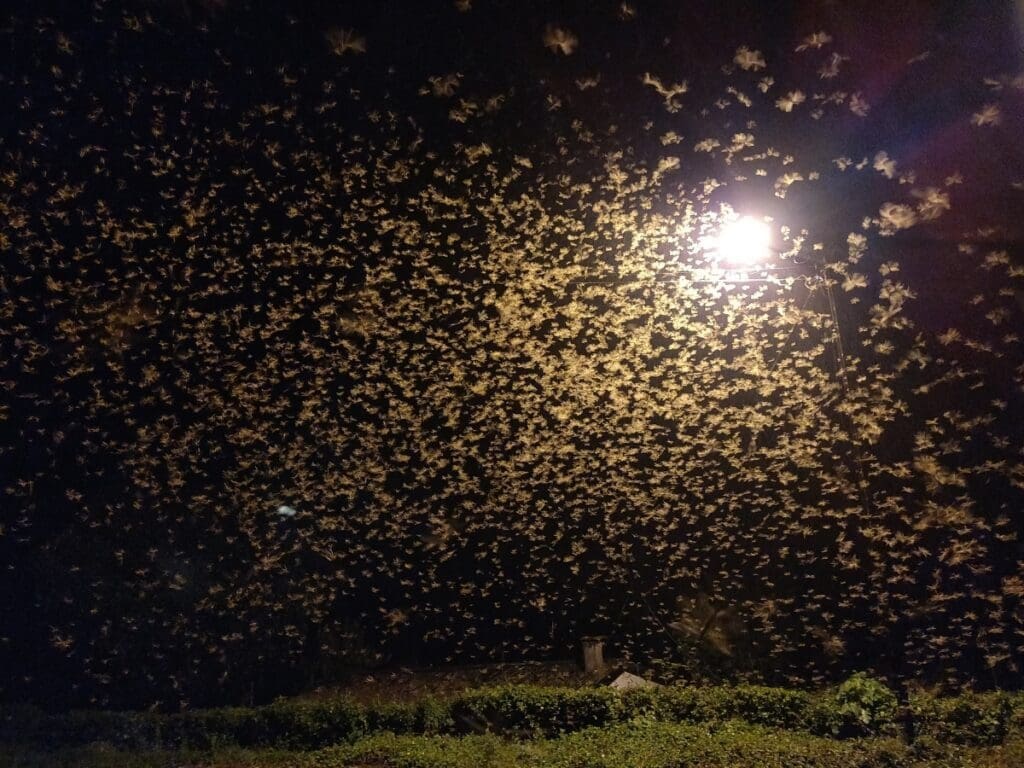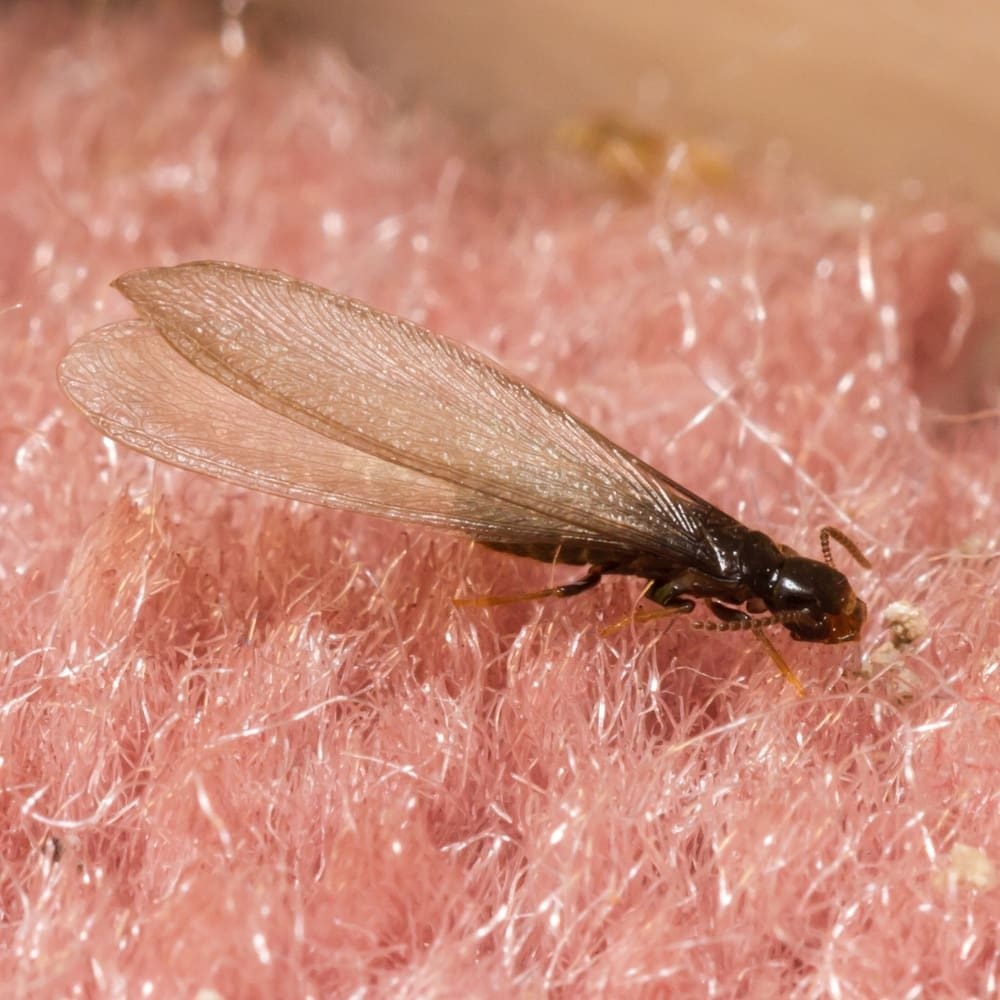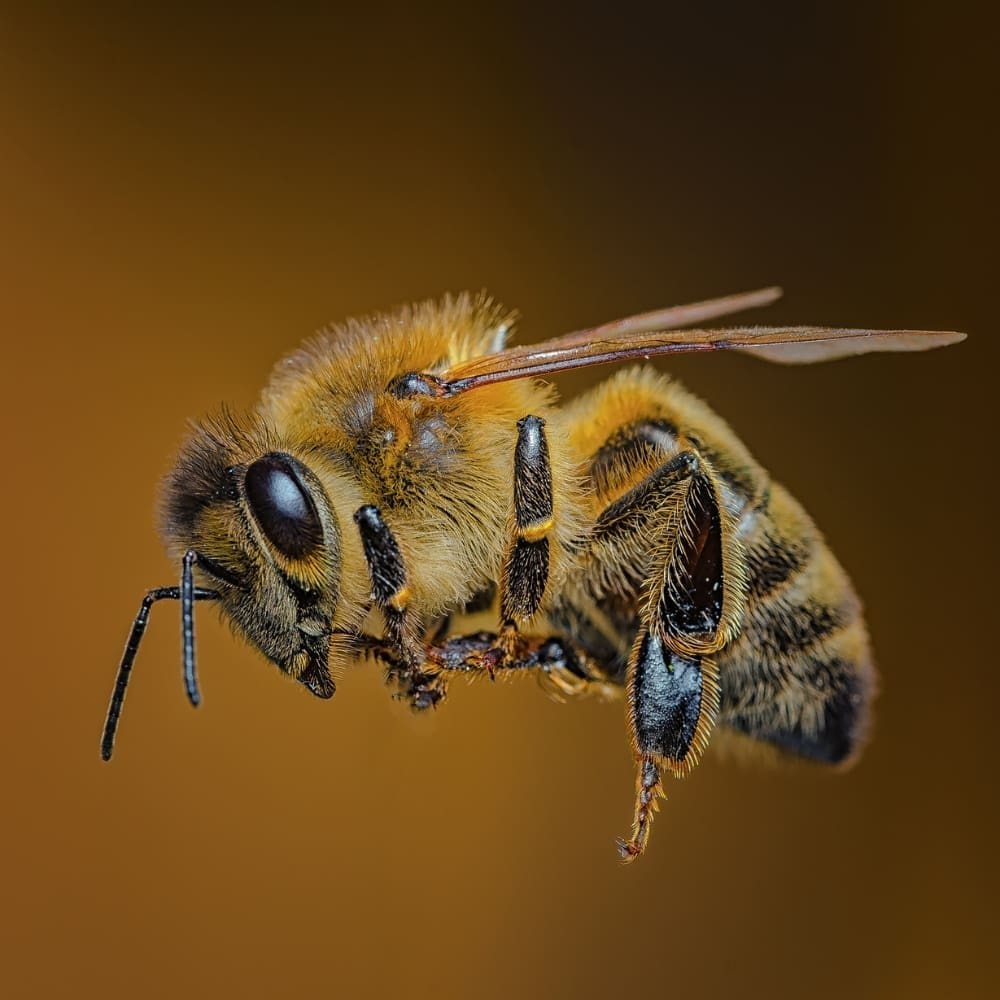
As winter ends and temperatures start to warm, numerous insects come out from their winter shelters to create new colonies and cause trouble in homes and gardens. These pests exploit spring’s ideal conditions—rising temperatures and increased moisture—to establish colonies that can threaten property integrity, human health, and outdoor enjoyment.
Recognizing these spring pests and taking effective control actions is essential in keeping your home free from infestations.
Pests That Swarm in Spring
Spring’s warm, humid climate triggers reproductive cycles in many pests, driving them to seek new habitats. Below are the most common spring swarmers and their unique threats.
Termites
- Swarming season: Early spring, often after rainfall or in warm, humid conditions.
- Signs: Discarded wings near windowsills, mud tubes on walls, or hollow-sounding wood.


Spring marks the beginning of termite swarming season, when winged reproductive termites, known as alates, emerge en masse to establish new colonies. These swarms typically occur on warm days following rainfall, particularly during late morning or early afternoon hours. A termite swarm near or inside a home is often the first visible sign of an infestation that may have been present for years.
Carpenter Ants
- Swarming season: Late spring to early summer, triggered by warm temperatures and sunlight.
- Signs: Trails of ants, sawdust piles, or winged “swarmers” near food sources.


Carpenter ants typically appear in early spring as they search for food and potential sites for new colonies. These sizable black or reddish ants can inflict considerable structural damage by hollowing out wood to build their nests. In contrast to termites, they do not consume wood; instead, they form intricate tunnel systems within them, which can undermine the stability of wooden structures.
Termites and ant swarmers can be mistaken for each other due to their almost similar appearance. You can read more about differentiating between the two in this article.
Bees and Wasps
- Swarming season: Bees swarm in spring as colonies expand; wasp queens emerge in early spring to build nests.
- Signs: Visible nests in eaves, trees, or wall voids; increased buzzing activity.


Spring awakens queen bees and wasps from their winter dormancy and triggers their search for suitable nesting sites. While these insects play important roles in pollination and natural pest control, their proximity to human habitation can pose risks.
Honeybee swarms are relatively harmless and are more of a nuisance, while carpenter bees typically cause structural damage. Wasps may carry more risk to humans due to how protective they are of their nests.
How to Get Rid of Spring Swarmers
Effective pest management for spring swarmers requires species-specific strategies. Below are targeted approaches for these common invaders.
How to Get Rid of Swarming Termites and Ants
| Method | How It Works | Best For |
| Vacuuming | Immediate removal of visible swarmers; prevents mating and colony expansion | Small, localized swarms |
| Bug Zappers | UV light attracts and electrocutes winged pests | Outdoor areas near entry points |
| Boric Acid Baits | Slow-acting poison transferred to colony via grooming | Long-term colony elimination |
Visually check for potential entry points of the swarmers, and vacuum the insects you can observe. Both full-sized and handheld vacuums are effective, but be sure to use a hose attachment. After vacuuming, immediately remove and replace the vacuum bag to prevent the pests from escaping. Disposing the bag or its contents correctly ensures the swarmers do not survive and return to your home.
Electric bug zappers are very effective at eliminating various flying insects, including flying carpenter ants and swarming termites, which are drawn to the heat and light emitted by the device. Simply hang the bug zapper in a spot where swarmers are likely to congregate and allow it to eliminate any winged ants and termites that come close.
If you’re aiming for long-term pest control, boric acid baits are an effective tool since they target the social behavior of these insects. These baits use a slow-acting poison that worker ants or termites unknowingly carry back to their nests during grooming and food-sharing. The poison spreads through the colony, ultimately eliminating the workers and the queen, leading to colony collapse.
How to Get Rid of Swarming Bees and Wasps
| Method | How It Works | Best For |
| Beekeeper Relocation | Professionals transfer swarms to managed hives using smoke calming | Honeybee swarms (non-aggressive) |
| Foaming Aerosol Sprays | Projectile foam expands to suffocate entire nests | Paper wasps & elevated nests |
| Soap-Water Solution | Clogs spiracles (breathing pores) in ground-dwelling yellowjackets | Underground wasp/hornet nests |
If you discover a honeybee swarm, contact local beekeepers or bee rescue organizations. They have the expertise and equipment to relocate honeybees safely, ensuring their survival and preventing harm to them or the environment. Many beekeepers will gladly take the bees off your hands for their hives.

For a quick and effective knockdown of wasps, use wasp-specific aerosol sprays. These foams are designed to reach the nest from a safe distance and effectively kill wasps on contact. Always follow the instructions on the label and take safety precautions, including wearing protective clothing to avoid stings during the process.
A soap-water solution is an eco-friendly method for controlling yellowjackets and wasp nests. When applied to nest entrances, this mixture (2 tablespoons of soap per quart of water) penetrates their exoskeletons and clogs their spiracles (tiny breathing pores). It is most effective when poured into entry holes of subterranean nests during cooler evenings. Make sure you wear protective clothing first.
Stopping Spring Swarmers Before They Strike
To prevent swarms from invading your living space, it’s important to take proactive measures. Here’s how to stop swarmers before they become a problem or before they reinfest your home.
1. Address Nearby Nests to Prevent Reinfestation
Swarming termites and ants are a sign of an active colony within or near your home. Eliminating nearby nests is necessary for long-term prevention:
- Locate and treat ant colonies in your yard using appropriate baits or professional-grade insecticides.
- For honeybee swarms, contact a local beekeeper for safe removal and relocation.
- If termite activity is detected, consider installing a comprehensive baiting system around your property to eliminate colonies before they can swarm.
2. Seal All Possible Entry Points
Creating physical barriers is your first line of defense against spring pests:
- Thoroughly inspect and seal all cracks and crevices in foundation walls using high-quality caulk or concrete filler.
- Install weather stripping around doors and windows to close off tiny gaps.
- Repair or replace damaged screens on windows and vents.
- Eliminate wood-to-ground contact around the structure by ensuring a gap between wooden elements and soil.
- Pay special attention to areas where utilities enter your home, sealing these openings with appropriate materials.
- Check for and seal any gaps in exterior walls, especially near pipes or electrical conduits.
3. Eliminate Attractive Nesting Sites
Reduce potential nesting areas around your property:
- Remove wood mulch and plant debris from your garden or porch, as these can attract termites.
- Keep firewood, lumber, and paper products away from the house and elevated off the ground.
- Remove dead trees, stumps, and fallen branches from your property.
- Regularly inspect and maintain wooden structures like decks, fences, and sheds.
4. Maintain a Protective Perimeter
Create a barrier around your home to deter pests:
- Establish a 12 to 18-inch bare soil area around your foundation, which helps monitor for termite activity and discourages nesting.
- Trim trees and bushes so that branches don’t touch the house, eliminating potential bridges for pests.
- Consider applying a perimeter treatment with pet-safe, non-repellent insecticides to create a protective zone.
5. Regular Inspections and Professional Assessments
Stay vigilant and seek expert help if necessary, particularly if your property is prone to swarming pests:
- Conduct regular visual inspections of your property, looking for signs of pest activity such as mud tubes or wood damage.
- Schedule annual professional pest inspections to catch potential infestations early.
- If you spot signs of an active colony, consult with a pest control professional about targeted treatments or baiting systems.
When to Call for Professional Pest Control

1. Recurring Infestations
If you’re experiencing recurring infestations of ants or termites despite your best DIY attempts, it’s a clear sign that the issue is more severe than you can manage alone. While DIY strategies might offer short-term relief, they frequently overlook the underlying causes, enabling these pests to return to your home.
2. Structural Damage
A major warning sign of a pest infestation, especially termites, is the appearance of hollow wood or deteriorating drywall. These damages suggest substantial termite activity that may threaten your home’s structural integrity. If you notice any of these issues, it is essential to reach out to a professional pest control service right away to avoid additional harm.
3. Large Nests
Spotting large nests of bees or wasps, especially in high-traffic areas around your property, is not just a nuisance but also poses serious risks of stings. If you encounter such nests, especially if they are close to places where children or pets play, calling in pest control experts is essential for safe and effective removal.
4. Safety Concerns
If you encounter potentially hazardous chemicals or aggressive swarms, it’s a clear sign to seek professional assistance. Pest control professionals are equipped to handle these scenarios safely. They have access to the right protective gear and strategies that reduce the risks to you and your family.
Conclusion
Spring swarms of termites, ants, bees, and wasps demand vigilance, and early intervention protects both your home and your health, allowing you to enjoy the season pest-free. For persistent or dangerous infestations, calling a professional pest control company can ensure safe and effective eradication.
Spring swarmers invading your space? Get expert help immediately—contact MMPC today for reliable, eco-friendly pest control.
